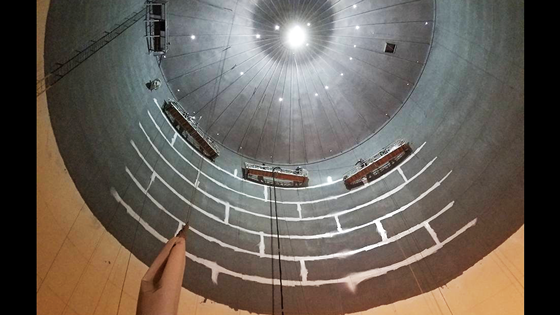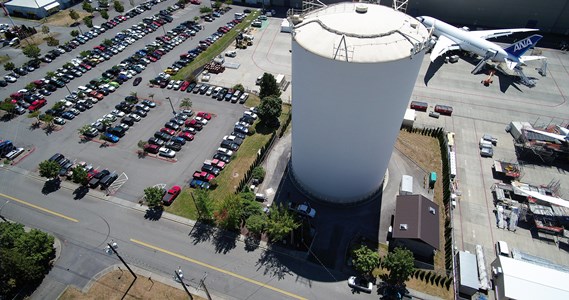Formed in 1920, the Mukilteo Water & Wastewater District is the oldest active water district in the state of Washington. It provides water and wastewater services to customers north of Seattle in the Mukilteo region along Puget Sound.
Back in 2016, the Mukilteo Water & Wastewater District had a water tower that was in need of refurbishment, and they contracted with the engineering firm Gray & Osborne to develop a comprehensive contract specification. It was a big facility: a 4.5 million gallon (17 million L) potable and fire water reservoir used by the water district.
Randy Cornelius was up for the job. He is the vice president of HCI Industrial & Marine Coatings, Inc., a Vancouver, Washington-based Society for Protective Coatings (SSPC) Qualification Procedure (QP) 1 and QP-2 Certified Coatings Contractor. They specialize in industrial and marine coatings, sandblasting and surface preparation, and floor, deck, and secondary containment coatings.
“It was a public works project, and HCI bid on it, along with eight or nine other industrial painting contractors,” Cornelius said. “Ultimately, HCI met the prequalification criteria and was awarded the project.”
Team Communication
It was HCI’s first time working with the Mukilteo Water & Wastewater District (MWWD), and there were a few extra complications on the job.
For one, the water reservoir was in the middle of Paine Field, which meant it was surrounded by new 777 and Airforce Refueling Tankers. That proximity meant Boeing was actually involved in the project because the reservoir supplied fire water for sprinkler systems to Boeing’s manufacturing facilities. In addition a FOD, or Foreign Object Debris Program, had to be developed and implemented to eliminate possible damage to new turbine engines from FOD Ingestion.
The reservoir was also a public drinking water supply, so other regulatory agencies were involved as well. Cornelius said everyone worked together as a team, though. “Everyone was very good to work with,” he said. “There were a lot of people involved in the project.”
“But everything went smoothly coordinating with all the different players,” Cornelius added. “We did a good job keeping them updated and had regular meetings. Most of the people showed up on time and were present at the meetings, so everyone was on board and up to date, and that helped the project run smoothly.”
Making a Plan
The biggest challenge on the job was the extremely tight timeframe.
The reservoir had to be shut down during the interior work, and the reliance on the water by Boeing and the water district heightened the stakes. The reservoir would be offline 24 hours a day, so any additional delays in returning the reservoir to service would be a significant cost to not only Boeing but also the water district, which of course also meant a significant cost to HCI Industrial & Marine Coatings, Inc.
“We hired a fabrication subcontractor to come in and cut a door sheet in the bottom of tank, a 10-foot by 10-foot [3 m x 3 m] hole in the bottom so we could drag our equipment inside the tank,” Cornelius said. “From the moment that we made the first cut in the side of the tank, our clock started, we had to get inside, rig the tank, blast it, coat it, clean it, put the steel sheet back inside the tank, and turn the project back over to the customer.” And it had to be “serviceable and ready to use in 50 days, which was extremely challenging,” he said.
As if that was not enough, the reservoir was 145 feet (44.2 m) above ground, and it was very large — approximately 50,000 square feet (4,645.1 m²).
But Cornelius and his crew of 12 men rose to the occasion. There would be eight men in the air, plus a foreman, superintendent, and two ground men.
Forging Ahead
The job was broken up into two phases: interior and exterior.
For the exterior, the team first did a SSPC Surface Preparation (SP) 1: Solvent Cleaning. They washed the reservoir and applied a spot prime coat on all prepared bare steel surfaces. They put down one coat of Sherwin-Williams Macropoxy 646 Fast Cure Epoxy at 3 to 5 mils (76.2‒127.0 microns) dry film thickness (DFT) using rollers and brushes.

All bolted connections, welds, and irregular surfaces were also brushed to ensure complete coverage and adequate film thickness.
Next, they installed an intermediate coat of Sherwin-Williams Macropoxy 5000 penetrating primer/sealer at 1 to 1.5 mils (25.4‒38.1 microns) DFT, also using rollers and brushes. Lastly, they added a finish coat of Sherwin-Williams Acrolon Ultra high-performance polyurethane. That was applied at 2 to 3 mils (50.8‒76.2 microns).
When the job first started, there was talk of painting a mural on the exterior of the tank. “But no one could agree on its design, so luckily we didn’t end up having to do it,” Cornelius said.
For the interior, the plan was to sandblast and then apply 25 to 35 mils (635.0‒889.0 microns) of plural-component spray applied Sherwin-Williams SherPlate PW Epoxy.
The first coat was a stripe coat to all welds, edges, and irregular surfaces, and then they applied a finish coat immediately after. The interior pitting was filled with Sherwin-Williams Steel-Seam FT910 epoxy.
Because of the size of the water reservoir, it was very important to provide enough equipment to get the project done on time and to control the environmental conditions. So the crew used two Sullair 1600 cfm (45.3 m³/min.) compressors and Vanair dryers, which were banked into a 28-ton (25.4 metric tons) eight-hole Schmidt abrasive pot with a 32-ton (29.0 metric tons) hopper. They also used a Munters 7000 cfm (198.2 m³/min.) dehumidifier with 100-amp heater banks, and an EnTech 40,000 cfm (1132.7 m³/min.) dust collection unit was used to create a negative air environment.
HCI provided an SSPC Protective Coatings Inspector (PCI) Level III Quality Control Inspector, and the MWWD provided Mike Ficca of Custom Coating Consultants for third-party hold point inspections.
Cornelius also hired T-Bailey, a subcontractor, to install fall protection anchors and painters plugs in the roof so the team could use them as rigging for both the interior and exterior of the tank. Gloves, masks, and other required safety equipment were also used during the job.
Difficult, Demanding, and Dangerous
Throughout the project, Cornelius was very concerned with meeting the tight 50-day timeline for the interior work. “It was very difficult, very demanding, very dangerous work, and took an extraordinary amount of planning to get it done and get it done safely,” he said.
But in the end, the effort paid off, as the HCI crew finished both the interior and exterior of the tank a full three days ahead of schedule.
